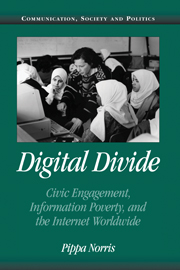Book contents
- Frontmatter
- Contents
- List of Tables
- List of Figures
- Preface
- PART I INTRODUCTORY FRAMEWORK
- 1 The Digital Divide
- 2 Understanding the Digital Divide
- 3 Wired World
- 4 Social Inequalities
- PART II THE VIRTUAL POLITICAL SYSTEM
- PART III THE DEMOCRATIC DIVIDE
- Appendix A Nations in the Study and Abbreviated Names Used in Figures
- Notes
- Select Bibliography
- Index
4 - Social Inequalities
Published online by Cambridge University Press: 05 June 2012
- Frontmatter
- Contents
- List of Tables
- List of Figures
- Preface
- PART I INTRODUCTORY FRAMEWORK
- 1 The Digital Divide
- 2 Understanding the Digital Divide
- 3 Wired World
- 4 Social Inequalities
- PART II THE VIRTUAL POLITICAL SYSTEM
- PART III THE DEMOCRATIC DIVIDE
- Appendix A Nations in the Study and Abbreviated Names Used in Figures
- Notes
- Select Bibliography
- Index
Summary
For many the phrase “digital divide” has become a familiar catch phrase signifying the gap between information haves and have-nots, including splits along racial, gender, and class lines. The U.S. Department of Commerce has drawn attention to these disparities in successive studies since 1993. Falling through the Net emphasizes the lack of access to computers and the Internet commonly found in America among poorer households, those with only high-school education, the black and Hispanic populations, rural communities and women. Pew surveys in spring 2000 confirm the familiar pattern found in many American studies, with sharp inequalities of Internet access by age, education, race, and ethnicity, plus the more modest gender gap (see Figure 4.1). Three-fourths of all American college graduates use the Internet compared with fewer than one-fifth of those who failed to graduate from high school. One-half of all whites are online compared with one-third of all blacks. And two-thirds of the younger generation is online compared with one in ten senior citizens. The OECD has documented similar patterns of stratification among the Internet population in Canada, Australia, and Finland.
Why does this matter? The chief concern about the digital divide is that the underclass of info-poor may become further marginalized in societies where basic computer skills are becoming essential for economic success and personal advancement, entry to good career and educational opportunities, full access to social networks, and opportunities for civic engagement.
- Type
- Chapter
- Information
- Digital DivideCivic Engagement, Information Poverty, and the Internet Worldwide, pp. 68 - 92Publisher: Cambridge University PressPrint publication year: 2001
- 1
- Cited by

